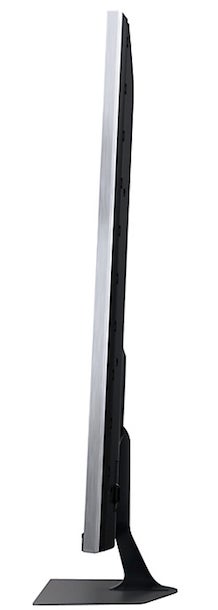Philips 55PUS7809 Review - Picture Quality Review
Picture Quality
Philips delivers a 4K TV for just £1,500

Sections
- Page 1 Philips 55PUS7809 Review
- Page 2 Picture Quality Review
- Page 3 3D, Sound and Conclusions Review
The curse of the IPS panel strikes again, we’re afraid, as a lot of great work by the 55PUS7809 is ultimately rendered moot by a deeply unsatisfying contrast performance.
Watch any dark scene on the 55PUS7809 and you’re immediately struck by some quite noticeable greyness hanging over parts of pictures that should look black. This immediately makes such scenes look much less realistic than they do on rival non-IPS screens. But that’s just the start of the problems.
Also severely problematic is the way the 55PUS7809 ends up crushing details out of dark areas of the picture thanks to the way the backlight has to work so hard to try and compensate for the core panel’s fundamental lack of contrast. This leaves the darkest parts of pictures looking flat and hollow, while bright parts of predominantly dark images look like they’ve been torn out of an empty background rather than feeling naturally integrated into the image.
 Another unpleasant side effect of the TV having to work so hard to counter its core lack of black level finds the image’s black level response and overall brightness level jumping around quite alarmingly as a film or TV programme cuts between dark and bright shots – so much so that the difference almost feels like someone’s flicking a light switch on and off at times.
Another unpleasant side effect of the TV having to work so hard to counter its core lack of black level finds the image’s black level response and overall brightness level jumping around quite alarmingly as a film or TV programme cuts between dark and bright shots – so much so that the difference almost feels like someone’s flicking a light switch on and off at times.
It’s noticeable, too, that when the panel is having to work hard to illuminate a bright scene you can see a couple of quite distinct patches of backlight inconsistency/clouding creeping into the top left and right corners of the picture. These are especially distracting if you’re watching films with black bars above and below, and when you’ve darkened your room for a serious film watching session.
The 55PUS7809 doesn’t have any local dimming systems on board to tackle the its basic contrast problems. This does mean, on the upside, that you don’t have to worry about the localised light ‘stripes’ sometimes seen with IPS-based TVs that do use local dimming. But it also makes it doubly hard for the Philips set to produce a believable black without manipulating the overall luminance level too aggressively.
The 55PUS7809’s numerous contrast problems have pretty much already ruined its chances of bagging a recommendation from us, despite its affordability. But for the record it does show signs of strength elsewhere.
With native 4K sources, for instance, it does a superb job of delivering every pixel of the UHD format’s extra clarity and detail. In fact, pictures are so detailed they almost seem to go beyond 4K in areas of extreme detail, such as ripples on the sea, leaves on trees and pores in skin. Yet crucially whatever Philips is doing to achieve this doesn’t result in grain or stressy edging around contrasty objects. The 55PUS7809’s exceptional 4K sharpness is particularly welcome given that Philips’ 2013 4K TV was a touch soft compared with some of its rivals.
Also playing a significant role in the 4K success is the 55PUS7809’s mostly outstanding colour performance. It delivers gorgeously rich, dynamic tones that give images a stand-out sense of pop and dynamism. Yet this colour vibrancy doesn’t come at the cost of the sort of tonal subtleties required to deliver the sort of colour blend finesse possible with UHD/4K pixel densities. This is blissfully apparent in the different shades of blades of grass in a football pitch, or the authentic look to skin tones.
It’s great to see, too, that the stunning sharpness of 4K feeds doesn’t go AWOL over motion, so long as you use the Natural Motion circuitry on its minimum setting (the best option, since this doesn’t result in excessive haloing artefacts around moving objects).
It’s also important to stress that while dark scenes are flawed, bright content of the sort that makes up the majority of most household’s viewing time looks really good. The incredible verve of the colour palette joins with a strong brightness output to really illuminate the screen and, in doing so, disguise quite handily the black level shortcomings.
These black level shortcomings are also, to be fair, much less alarming if you’re watching in a room with quite a bit of ambient light in it. Though such a room set up also highlights the fact that the top sheet across the 55PUS7809’s front is more reflective than we’d ideally like.

Kudos, too, to Philips’ upscaling processing. This draws on Philips’ long heritage of detail enhancement to deliver HD sources with an exceptional sense of sharpness and texture. Yet crucially, so long as you reduce the sharpness a little from its default position, this sense of extreme detail in upscaled pictures isn’t accompanied by excessive levels of noise.
The processing struggles a bit more – understandably – with standard definition content, finding it harder to sort the source noise from the ‘proper’ picture information when deciding what to upscale. But it’s certainly not a bad effort, especially in the way it retains accurate and vibrant colour tones.
There’s also a small benefit with viewing angles versus non-IPS panels, at least when bright content is showing. With dark content you can still see some localised light issues fairly readily during off-axis viewing.
Make no mistake: when the 55PUS7809 looks good, it looks spectacular. It’s just a shame Philips’ clear 4K talents have been allied here with a low-contrast IPS panel and insufficient backlight controls.
How we test televisions
We test every TV we review thoroughly over an extended period of time. We use industry standard tests to compare features properly. We’ll always tell you what we find. We never, ever, accept money to review a product.

